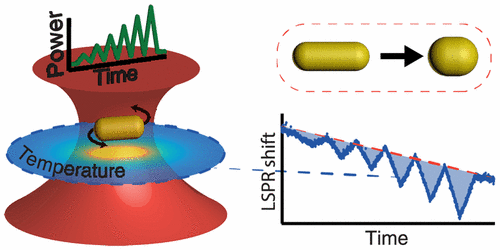Our official English website, www.x-mol.net, welcomes your
feedback! (Note: you will need to create a separate account there.)
Probing Photothermal Effects on Optically Trapped Gold Nanorods by Simultaneous Plasmon Spectroscopy and Brownian Dynamics Analysis
ACS Nano ( IF 15.8 ) Pub Date : 2017-09-20 00:00:00 , DOI: 10.1021/acsnano.7b04302 Daniel Andrén 1 , Lei Shao 1 , Nils Odebo Länk 1 , Srdjan S. Aćimović 1 , Peter Johansson 1, 2 , Mikael Käll 1
ACS Nano ( IF 15.8 ) Pub Date : 2017-09-20 00:00:00 , DOI: 10.1021/acsnano.7b04302 Daniel Andrén 1 , Lei Shao 1 , Nils Odebo Länk 1 , Srdjan S. Aćimović 1 , Peter Johansson 1, 2 , Mikael Käll 1
Affiliation

|
Plasmonic gold nanorods are prime candidates for a variety of biomedical, spectroscopy, data storage, and sensing applications. It was recently shown that gold nanorods optically trapped by a focused circularly polarized laser beam can function as extremely efficient nanoscopic rotary motors. The system holds promise for applications ranging from nanofluidic flow control and nanorobotics to biomolecular actuation and analysis. However, to fully exploit this potential, one needs to be able to control and understand heating effects associated with laser trapping. We investigated photothermal heating of individual rotating gold nanorods by simultaneously probing their localized surface plasmon resonance spectrum and rotational Brownian dynamics over extended periods of time. The data reveal an extremely slow nanoparticle reshaping process, involving migration of the order of a few hundred atoms per minute, for moderate laser powers and a trapping wavelength close to plasmon resonance. The plasmon spectroscopy and Brownian analysis allows for separate temperature estimates based on the refractive index and the viscosity of the water surrounding a trapped nanorod. We show that both measurements yield similar effective temperatures, which correspond to the actual temperature at a distance of the order 10–15 nm from the particle surface. Our results shed light on photothermal processes on the nanoscale and will be useful in evaluating the applicability and performance of nanorod motors and optically heated nanoparticles for a variety of applications.
中文翻译:

同时等离子光谱和布朗动力学分析对光陷金纳米棒的光热效应进行研究
等离子体金纳米棒是各种生物医学,光谱学,数据存储和传感应用的主要候选材料。最近显示,被聚焦的圆偏振激光束光学捕获的金纳米棒可以用作极其有效的纳米旋转电机。该系统有望用于从纳米流体流动控制和纳米机器人到生物分子驱动和分析的各种应用。但是,要充分利用这一潜力,就需要能够控制和了解与激光陷波有关的热效应。我们通过同时探测其局部表面等离振子共振谱和扩展的旋转布朗动力学,研究了单个旋转的金纳米棒的光热加热。数据显示,纳米颗粒的重塑过程非常缓慢,涉及每分钟几百个原子的迁移,以获得适中的激光功率和接近等离激元共振的捕获波长。等离子体激元光谱和布朗分析可以基于被困的纳米棒周围的水的折射率和粘度来进行单独的温度估算。我们表明,两次测量都产生相似的有效温度,该温度对应于距粒子表面10-15 nm量级的实际温度。我们的研究结果揭示了纳米级的光热过程,将有助于评估纳米棒电机和光学加热的纳米颗粒在各种应用中的适用性和性能。等离子体激元光谱和布朗分析可以基于被困的纳米棒周围的水的折射率和粘度来进行单独的温度估算。我们表明,两次测量均产生相似的有效温度,该温度对应于距粒子表面10–15 nm量级的实际温度。我们的研究结果揭示了纳米级的光热过程,将有助于评估纳米棒电机和光学加热的纳米颗粒在各种应用中的适用性和性能。等离子体激元光谱和布朗分析可以基于被困的纳米棒周围的水的折射率和粘度来进行单独的温度估算。我们表明,两次测量都产生相似的有效温度,该温度对应于距粒子表面10-15 nm量级的实际温度。我们的研究结果揭示了纳米级的光热过程,将有助于评估纳米棒电机和光学加热的纳米颗粒在各种应用中的适用性和性能。它对应于距粒子表面约10–15 nm距离处的实际温度。我们的研究结果揭示了纳米级的光热过程,将有助于评估纳米棒电机和光学加热的纳米颗粒在各种应用中的适用性和性能。它对应于距粒子表面约10–15 nm距离处的实际温度。我们的研究结果揭示了纳米级的光热过程,将有助于评估纳米棒电机和光学加热的纳米颗粒在各种应用中的适用性和性能。
更新日期:2017-09-20
中文翻译:

同时等离子光谱和布朗动力学分析对光陷金纳米棒的光热效应进行研究
等离子体金纳米棒是各种生物医学,光谱学,数据存储和传感应用的主要候选材料。最近显示,被聚焦的圆偏振激光束光学捕获的金纳米棒可以用作极其有效的纳米旋转电机。该系统有望用于从纳米流体流动控制和纳米机器人到生物分子驱动和分析的各种应用。但是,要充分利用这一潜力,就需要能够控制和了解与激光陷波有关的热效应。我们通过同时探测其局部表面等离振子共振谱和扩展的旋转布朗动力学,研究了单个旋转的金纳米棒的光热加热。数据显示,纳米颗粒的重塑过程非常缓慢,涉及每分钟几百个原子的迁移,以获得适中的激光功率和接近等离激元共振的捕获波长。等离子体激元光谱和布朗分析可以基于被困的纳米棒周围的水的折射率和粘度来进行单独的温度估算。我们表明,两次测量都产生相似的有效温度,该温度对应于距粒子表面10-15 nm量级的实际温度。我们的研究结果揭示了纳米级的光热过程,将有助于评估纳米棒电机和光学加热的纳米颗粒在各种应用中的适用性和性能。等离子体激元光谱和布朗分析可以基于被困的纳米棒周围的水的折射率和粘度来进行单独的温度估算。我们表明,两次测量均产生相似的有效温度,该温度对应于距粒子表面10–15 nm量级的实际温度。我们的研究结果揭示了纳米级的光热过程,将有助于评估纳米棒电机和光学加热的纳米颗粒在各种应用中的适用性和性能。等离子体激元光谱和布朗分析可以基于被困的纳米棒周围的水的折射率和粘度来进行单独的温度估算。我们表明,两次测量都产生相似的有效温度,该温度对应于距粒子表面10-15 nm量级的实际温度。我们的研究结果揭示了纳米级的光热过程,将有助于评估纳米棒电机和光学加热的纳米颗粒在各种应用中的适用性和性能。它对应于距粒子表面约10–15 nm距离处的实际温度。我们的研究结果揭示了纳米级的光热过程,将有助于评估纳米棒电机和光学加热的纳米颗粒在各种应用中的适用性和性能。它对应于距粒子表面约10–15 nm距离处的实际温度。我们的研究结果揭示了纳米级的光热过程,将有助于评估纳米棒电机和光学加热的纳米颗粒在各种应用中的适用性和性能。











































 京公网安备 11010802027423号
京公网安备 11010802027423号